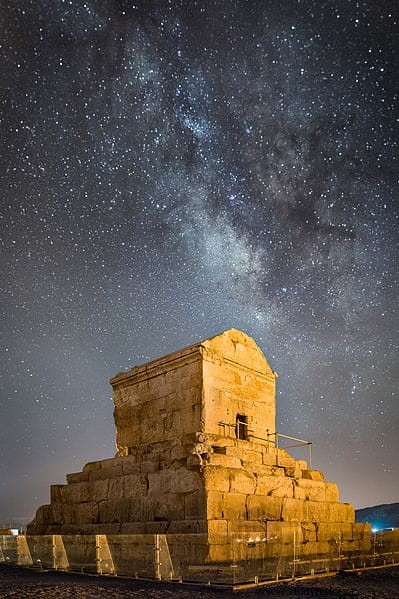Cyrus II the Great was the founder of the Achaemenid Persian Empire, after his victory over the Medes in 550 BC, reigning until his death in 529 BC.
His conquests gave rise to the largest empire known until then, which stretched from the Mediterranean to India, and which would last more than two hundred years, until Alexander the Great arrived.
However, contrary to what happens with the last resting place of the Macedonian, still unknown, the tomb of Cyrus the Great has stood for more than 2,500 years near the Pasargada site. in Iran, a kilometer away from what was the first capital of the empire.

Or at least the one that was identified as such by the Greeks. Alexander would have ordered the historian Aristobulus of Cassandrea to enter the tomb. According to his description, now lost but cited by Flavio Arriano in his Anabasis from the 2nd century AD, there he found a sarcophagus of gold, precious stones and an inscription. Strabo indicates that this inscription read:
However no inscription is visible today and there is actually no evidence that it belongs to Cyrus, although the tomb continues to be attributed to him following tradition. According to a legend, when the Arabs conquered the area, the guardians of the tomb convinced their military leader that the tomb was not that of Cyrus, but that of King Solomon's mother, which prevented its destruction. The Muslims simply erased the inscription, which was replaced by a verse from the Koran. The tomb that is identified is that of his son Cambyses II , which was also found in Pasargada in 2006.
In any case, what is interesting about the tomb, apart from its antiquity, symbolism and historical importance, is that it is the first known structure to incorporate seismic isolation, which has protected it from earthquakes throughout all these centuries. 
Built after the death of Cyrus in 529 BC, its design is a mix of styles that can be traced to Mesopotamian ziggurats and Urartu tombs, along with Babylonian, Assyrian and Egyptian influences. In fact, it seems that its dimensions are exactly the same as those of the tomb of Aliates II, the father of King Croesus of Lydia, discovered in 1854 near the river Hermus north of Sardes (modern Turkish Sart).
According to the description of Aristobulus the tomb was built on large square blocks of stone, on top of which other rectangular ones were arranged. Finally, the chamber with a roof and a door so small (according to the measurements of the archaeologists 1.39 meters high by 78 centimeters wide) that even for a short man it was difficult to access the interior. Cyrus's body rested inside a gold sarcophagus, surrounded by rich Babylonian fabrics, jewels and scimitars. Next to the sarcophagus there was a table ready to eat, with its crockery and cutlery.

Actually, according to geologists and archaeologists, the entire Pasargadae was built using seismic isolation , in a very similar way to the method used today in nuclear power plants and other buildings in risk areas. The buildings had a solid foundation of stone, founded using a mixture of lime stucco and ash or sand. On top of it was another layer of large polished stones held together by metal staples, which allowed the structure to vibrate and slide in the event of an earthquake. It seems that this system could withstand tremors of intensity 7 on the current Richter scale.
Proof of this may be that the tomb is still standing after 2,500 years, while the surrounding columns and supporting structure have almost completely disappeared.
